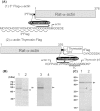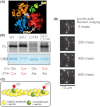Recombinant alpha-actin for specific fluorescent labeling
- PMID: 20009382
- PMCID: PMC3621554
- DOI: 10.2183/pjab.85.491
Recombinant alpha-actin for specific fluorescent labeling
Abstract
Until recently, actin was thought to act merely as a passive track for its motility partner, myosin, during actomyosin interactions. Yet a recent report having observed dynamical conformational changes in labeled skeletal muscle alpha-actin suggests that actin has a more active role. Because the labeling technique was still immature, however, conclusions regarding the significance of the different conformations are difficult to make. Here, we describe the preparation of fully active alpha-actin obtained from a baculovirus expression system. We developed alpha-actin recombinants, of which subdomains 1 and 2 have specific sites for fluorescent probes. This specific labeling technique offers to significantly expand the information acquired from actin studies.
Figures



Similar articles
-
Actomyosin kinetics and in vitro motility of wild-type Drosophila actin and the effects of two mutations in the Act88F gene.Biophys J. 1995 May;68(5):1991-2003. doi: 10.1016/S0006-3495(95)80376-0. Biophys J. 1995. PMID: 7612841 Free PMC article.
-
Preparation of filamentous actin for polarized total internal reflection fluorescence microscopy (polTIRFM) motility assays.Cold Spring Harb Protoc. 2012 May 1;2012(5):10.1101/pdb.prot069377 pdb.prot069377. doi: 10.1101/pdb.prot069377. Cold Spring Harb Protoc. 2012. PMID: 22550306 Free PMC article.
-
Structural implications of the chemical modification of Cys(10) on actin.Biophys J. 2000 Mar;78(3):1482-9. doi: 10.1016/S0006-3495(00)76701-4. Biophys J. 2000. PMID: 10692333 Free PMC article.
-
Development and application of probes for labeling the actin cytoskeleton in living plant cells.Protoplasma. 2011 Apr;248(2):239-50. doi: 10.1007/s00709-010-0202-0. Epub 2010 Aug 28. Protoplasma. 2011. PMID: 20803158 Review.
-
The complexity and diversity of the actin cytoskeleton of trypanosomatids.Mol Biochem Parasitol. 2020 May;237:111278. doi: 10.1016/j.molbiopara.2020.111278. Epub 2020 Apr 28. Mol Biochem Parasitol. 2020. PMID: 32353561 Review.
Cited by
-
A high-throughput fluorescence lifetime-based assay to detect binding of myosin-binding protein C to F-actin.J Gen Physiol. 2021 Mar 1;153(3):e202012707. doi: 10.1085/jgp.202012707. J Gen Physiol. 2021. PMID: 33600558 Free PMC article.
-
Spontaneous structural changes in actin regulate G-F transformation.PLoS One. 2012;7(11):e45864. doi: 10.1371/journal.pone.0045864. Epub 2012 Nov 5. PLoS One. 2012. PMID: 23144776 Free PMC article.
-
Dilated cardiomyopathy-associated skeletal muscle actin (ACTA1) mutation R256H disrupts actin structure and function and causes cardiomyocyte hypocontractility.Proc Natl Acad Sci U S A. 2024 Nov 12;121(46):e2405020121. doi: 10.1073/pnas.2405020121. Epub 2024 Nov 6. Proc Natl Acad Sci U S A. 2024. PMID: 39503885 Free PMC article.
References
-
- Mounier N. and Sparrow J.C. (1997) Structural comparisons of muscle and nonmuscle actins give insights into the evolution of their functional difference. J. Mol. Evo. 44, 89–97 - PubMed
-
- Sellers J.R. (1999) Myosins Second Edition. Oxford University Press, Oxford
-
- Oda T., Iwasa M., Aihara T., Maeda Y. and Narita A. (2009) The nature of the globular- to fibrous-actin transition. Nature 457, 441–445 - PubMed
-
- Kozuka J., Yokota H., Arai Y., Ishii Y. and Yanagida T. (2006) Dynamic polymorphism of single actin molecules in the actin filament. Nat. Chem. Biol. 2, 83–86 - PubMed

